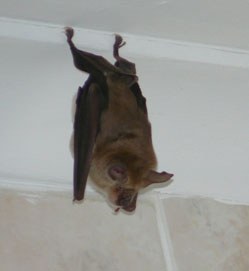Identification pointers
The distinguishing characteristics of this species of the genus are subtle, and there can be no accurate identification of this species without an expert opinion. But the Geoffroy’s horseshoe bat is the most widely encountered species of the genus in South Africa. They are greyish or reddish brown with paler fur below and dark wing membranes; ears are pointy but broad at the base. All horseshoe bats have pointy, conspicuous structures protruding from their noses and complex nose leaf anatomy. These structures facilitate the generation of their constant frequency echolocation call. Forearm length: 49-57 mm and mass ranges between 12-25 grams.
Roosting habits
Cavities such as disused buildings, caves, mine addits, cellars and similar places with a stable microclimate. In caves colonies can be enormous, reaching up to 10 000 in the Western and Eastern Cape, where they invaluably contribute to insect control. The verandas of houses and trees may be used as night roosts to feed on captured prey, and are also marked by the scattered remains of insect wings.
Breeding
A single young is born once a year in December, or during the warmest summer months.
Food
Distances of 10km from the roost may be covered in a foraging night, where moths and beetles are common prey. Gleaning is possible and they are slow-flying, clutter feeders, which means that they prefer thickets rather than grasslands as foraging habitat.






